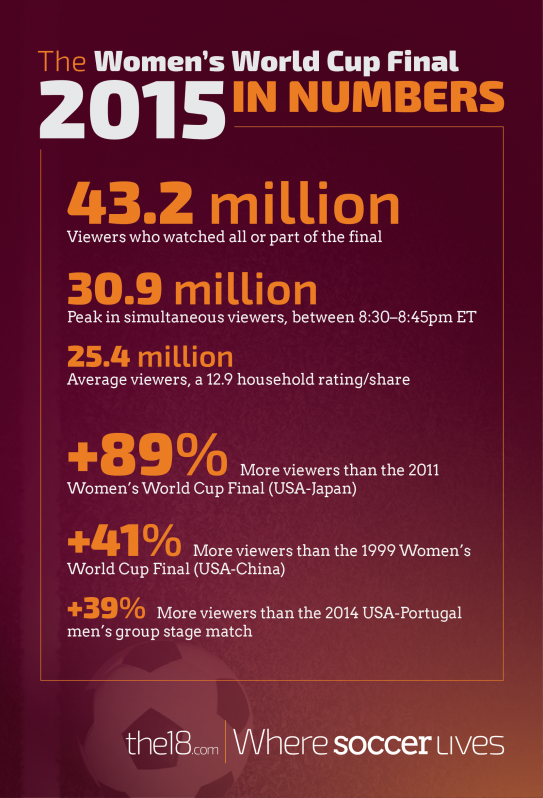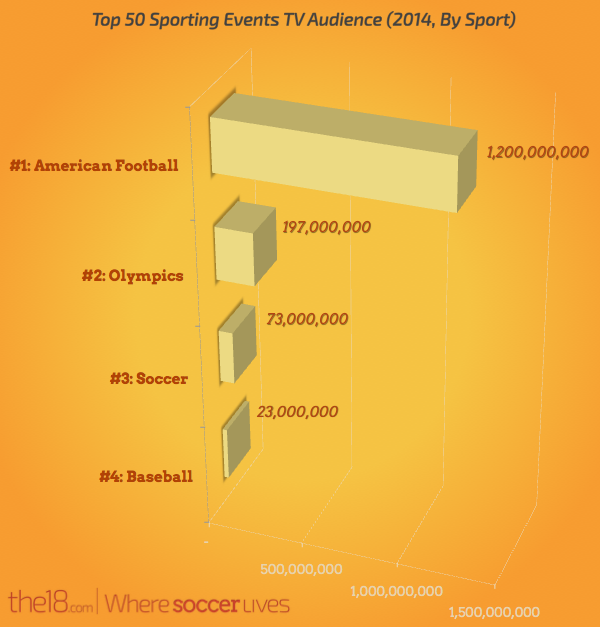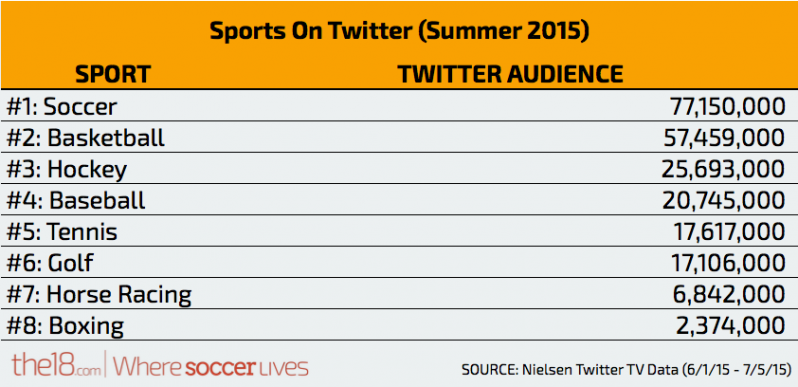The eyes of the nation have been on soccer for the past week, and deservedly so.
Last Sunday’s final between the United States Women’s National Team and Japan smashed all previous ratings records for soccer in the United States, never mind the fact that it was a broadcast of women’s soccer.

In the frenzy of coverage that has ensued, it’s hard not to notice a certain sense of surprise. Phrases like “incredible U.S. ratings” and “a whopping 26 million viewers” are thrown about in association with the raw fact that the 2015 final is the most-watched soccer match in American history.
It’s hard to know if the success of the final is so surprising because it is soccer we’re talking about, or a women’s sport. Likely it is both.
After all, the United States has been slow to adopt soccer as a serious interest, let alone a national pastime. Sure, a scrappy team of amateur U.S. men shocked England – birthplace of modern soccer – in the 1950 World Cup, but the excitement this created in the American psyche was likely as much pride in beating the Brits at their own game as it was a true sign of the United States embracing soccer.
As if to accentuate the point, it would be 40 years before the United States made another appearance in the World Cup and, in that time, American football, baseball and basketball would develop into megaliths – ingrained in our collective culture as the most American of pursuits, bolstered with countless dollars from advertisers’ deep pockets.
Meanwhile, soccer would toil in obscurity for decades, aside from a brief but glorious stint in the mid-70s when media executive Steve Ross brought the world’s greatest player, Pele, to New York to play for the fledgling Cosmos. (The excellent 2006 documentary Once In A Lifetime tells the story.) It was a grand experiment that seemed for a moment might work, with the Cosmos selling out to capacity crowds of 50,000+ at Giants Stadium and picking up a national TV contract with ABC. However, with the retirement of Pele in 1977, a match format that left advertisers scratching their heads (“…but what about TV timeouts?”), and poor consistent ratings for the North American Soccer League (NASL), the boom was short lived. The final death knell for professional soccer in the United States came in 1980 when ABC pulled the plug on its broadcast deal with the NASL – and along with it went the advertising dollars, and along with them went soccer’s audience in the United States. So is the story of sports in the modern age.
Which brings us to today and what is perhaps so surprising about the huge U.S. television ratings of the 2015 Women’s World Cup Final. In an era where blockbuster sporting events on TV are dominated by men’s sports of a distinctly American variety, along comes a women’s soccer match that breaks into the upper echelons of sports viewership.
Now, clearly, soccer (women’s or men’s) will pose no threat anytime soon to knocking the NFL off its perch as the most-watched professional sport on television in the United States. To provide some perspective, in 2014, 37 of the top 50 most viewed TV sporting events in the United States were NFL games – and top NFL rivalries during the regular season can easily draw audiences of 20+ million. No big surprise there (at least, for anyone with a pulse who happens to turn on the TV between September and Super Bowl Sunday).
What might surprise you, however, are the sports that cracked the top 50 beyond American football – and, maybe even more so, the sports that did not.

Looking at this data, you could of course argue that any national team event where it’s America versus the world – the Olympics and FIFA international football as prime examples – will be big enough to leap ahead of traditionally popular U.S. sports like baseball and basketball.
Chris Chase, of sports site For The Win, does indeed make this argument in a recent article, titled, “The huge World Cup TV ratings don't mean soccer is suddenly important in America.” (We kind of wish the title ended, “So put that in your pipe and smoke it, soccer lovers.”)
In the article, referring to the 2015 Women’s World Cup record ratings, Chase says, “This number has been, and will continue to be, misrepresented in the media as a grand sign that women’s soccer, and soccer in general, is a big-time sport in the country.”
He goes on to argue, “…we, as a country, like to wrap ourselves in the flag while watching sporting events. It has been this way and it will continue to be this way. Women’s soccer is an accepted, crossover sport that America now enjoys rather than tolerates. But that’s all.”
Chase is not the only one to pursue this line of thought. During the 2014 FIFA Men’s World Cup, well-known sports writers like Thom Loverro and Dan Shaughnessy authored pieces like “American soccer hysteria just hipster hype” and “Thank God we can now ignore the World Cup.” It’s hard not to notice in reading these articles that the authors seem genuinely offended by soccer or, maybe more accurately, soccer’s audience of young people. They say things like, “Soccer lovers tend to be an elitist, intolerant lot,” and, “This illustrates what I’ve always said about soccer — it’s the sport for people who don’t like sports.”
Now, don’t get me wrong, both of these articles are actually highly entertaining reads, in the same way that listening to your grandpa tell stories about what things were like “back in their day” is entertaining. And just like grandpa had strong opinions about things of the newfangled variety, these writers seem to regard soccer as something puzzling and vaguely un-American they have to endure – all the while wishing we would just stop talking about it and go back to watching the sports that our great-great-grandfathers invented (a.k.a real sports).
So it’s not surprising that in the aftermath of the huge ratings bonanza of the Women’s World Cup, we’re hearing again from male sports experts that we should ignore soccer because soccer – especially women’s soccer – is no big deal.
The argument these soccer naysayers make goes something like this: The World Cup may have had huge ratings, but let’s not get carried away. These ratings are simply a sign of national pride. Women’s soccer, and soccer in general, aren’t big-time sports in the United States. Like the sports played during the Olympics, soccer will soon fade back into obscurity until the next big, international event.
To put it bluntly, this argument misses the point – and wraps an argument about soccer as a whole inside one about a women’s league in its infancy, the NWSL. It’s a little like saying that because the Senior PGA Tour isn’t hugely watched on television, golf isn’t popular in America.
The fact of the matter is, the NWSL isn’t the best indicator of soccer’s “big-timey-ness” (yeah, that’s a word) – nor should it be, having launched less than 5 years ago. Even if we go all the way back to the world’s first professional women’s soccer league, the Women’s United Soccer Association, it only launched in 2000. (Which, incidentally, gives the NFL a 78-year head start to build a following.) So, to say that soccer isn’t “big time” because the NWSL doesn’t have a huge audience is somewhat irrelevant.
And unlike the Olympics – a collection of sporting events, many without well-known leagues – soccer is a single sport with many popular domestic and global leagues Americans can follow. And many, in fact, do. As one example, Major League Soccer has an average attendance of over 19,000, which is more than the average attendance of both the NHL and NBA (each around 17,000). As another, 116 million Americans watched Premier League soccer on television during the 2013-2014 season.
Then again, the NBA, MLB, NFL and (to a lesser extent) NHL all have strong TV ratings, so perhaps the bigger question we should be asking is why we enjoy watching the sports that we do.
For instance, is every American just born with an innate love of the NFL that compels us to tune in every Thursday, Sunday and Monday (and sometimes Fridays and Saturdays as well)? Are we automatically drawn to sports that have plenty of breaks into which much advertising can crammed? Or, could it be that TV media and advertisers have shaped our demand for sports, and even our enjoyment of them, in a very real way?
It doesn’t take a rocket scientist, or even a very savvy marketer, to understand that if you advertise the hell out of hamburgers, you’ll probably sell a Big Mac or two. Does that mean hamburgers are inherently more important to us than, say, pork chops? Or that our interest in pork chops couldn’t be elevated if someone with deep pockets decided to put little more effort into making them top-of-mind? (Case in point, the bizarre case of the extremely popular McRib and the McRib Locator.)
To put it differently, maybe we love American football – as well as other sports that Chris Chase and others would consider “big time” – because that’s what the mainstream TV media in America has sold us over the past 3 decades. And, just maybe, we primarily watch men’s sports because that’s what we’ve been sold historically as well.
But, maybe you don’t like analogies. Maybe you don’t like arguments about the role TV media plays in shaping demand. Maybe you agree with Chris Chase that our love of soccer has more to do with national pride than the sport itself, or maybe you agree with Sports Illustrated’s Andy Benoit that women’s sports are inherently not worth watching – no matter how much they are hyped by media.
Which is actually just fine, because maybe none of that matters anyways.
In an era where young people are watching less TV than ever, using television ratings as the primary indication of the popularity of a sport may quickly become a thing of the past.
Case in point: A recent Nielsen study shows that 18-24 year-olds are watching 25% less TV in 2015 than they did in 2014 – and this decrease is accelerating year-over-year. Maybe more surprising (although not to anyone paying half a wit of attention) is the fact that 13-24 year olds now watch more video online than they watch TV.
Even beyond young consumers, mainstream viewers are moving online. Viewership of live television and online streaming video are moving in opposite directions, with Nielsen reporting last year that in one quarter alone, TV viewership dropped -4% while online viewership jumped +60%.
And what sports benefit most from this shift in viewing behavior?
As you’ve probably guessed, it’s not necessarily the “big time” sports that soccer naysayers think are the only ones that matter to Americans. 90% of the NFL’s audience still watches on TV. The 2015 Super Bowl averaged 528,000 online streaming viewers and peaked at 1.3 million. As a point of comparison, the 2014 World Cup group stage match between the USMNT and Germany peaked at 1.7 million. (Online streaming figures have yet to be released for the 2015 World Cup at the time of this writing.)
Why does this matter? After all, numbers like 1.7 million are dwarfed by numbers like 114.4 million – the U.S. viewing audience for the 2015 Super Bowl (which makes it the most-watched event in American history).
It matters because smart brands and advertisers know that the quality of the audience matters more than the quantity, and, in the digital era, a quality audience is much more likely to be found online during sporting events than it is to be found in distracted living rooms across America.
To put it differently, the 80-20 rule states that in anything – especially marketing – 80% of the effects come from 20% of the causes. So, as an advertiser, you’d much rather reach the right 20% audience who will actually engage with you than you would reach a 100% audience who is too busy eating chips and socializing to pay attention to anything you say.
If this sounds like a bunch of theoretical mumbo jumbo, here’s some evidence to ponder.
A recent study of 70,000 ads on television showed that the more engaged an audience is with the show they are watching, the more likely they are to remember the content of ads the next day. Not rocket science, right?
Building on this fact, another study looked at ads for consumer packaged goods (CPGs) and showed that next-day recall is a leading indicator of the sales impact that advertising will have. No stretch there. People who remember ads are more likely to buy stuff based on those ads.
Here’s where it gets interesting.
Just this year, Nielsen conducted a study that looked at what Twitter activity can tell us about the engagement of the general population with the television shows they watch. Without getting overly scientific, Nielsen hooked 300 non-Twitter-using consumers up to machines and monitored their brain activity as they watched TV. They, then compared this group’s minute-by-minute level of engagement (i.e., when they were really paying attention) to minute-by-minute activity on Twitter during the same shows.
What they found is this: A high level of Twitter activity is a really, really good indicator – as in, better than TV ratings – of how engaged the general population is with TV programming, regardless of whether they are on Twitter or not. And remember, strong engagement means better performance of advertising.
What does any of this have to do with soccer? A few fun facts:
Fact #1: During the 2015 Women’s World Cup, tweets about #FIFAWWC were viewed 9 billion times – and only 1 billion of these views were during live matches. So, not only were the matches highly engaging, but this engagement was actually bigger in-between matches. Not bad if you’re an advertiser looking for an impact that lasts more than a few hours.
Fact #2: During the final between the USA and Japan, Carli Lloyd was the most tweeted about player (duh). According to one estimate, Lloyd was 200% more seen on social media last Sunday than all 30 MLB teams combined.
Fact #3: According to The18.com’s analysis of Nielsen Twitter TV data, the Women’s World Cup and soccer have had the largest audience of any sport on Twitter this summer – with a unique U.S. audience of 77 million people – during a stretch that included all 6 games of the 2015 NBA Finals (which had a U.S. audience of 58 million on Twitter) and all 5 matches of the 2015 Stanley Cup Final (which had a U.S. audience of 26 million on Twitter).

Fact #4: Looking at every sporting event so far in 2015 on Twitter, the Women’s World Cup Final between the USA and Japan is #5 on the list in terms of U.S. audience (11 million), unique authors (1.1 million) and tweets written (3.5 million).
Fact #5: Finally, soccer as a whole (men’s and women’s, international and league play), is a strong #3 in 2015 to-date (January 1st – July 5th) in terms of U.S. audience on Twitter (119 million) and tweets written (10.5 million) – ahead of baseball, hockey, golf and a number of other sports we’re confident soccer naysayers would consider “big time” in the United States.

Taken together, this data starts to paint a different picture of the relationship Americans have with soccer – and the relationship that media and advertisers may want to consider given the global nature of the sport and the strength of audience engagement.
This is not to say that soccer is making a grand takeover of the American sporting scene. It is not to say that everyone loves, or even should love soccer.
It is to say that when we spend time debating the TV ratings of a single World Cup match and what they may or may not mean, we are having the wrong conversation, or, at least, an incomplete conversation. Because, at the end of the day, it doesn’t matter what the TV ratings alone say. It doesn’t matter what we or a few other journalists think is or isn’t a big-time sport.
Consumer demand and the invisible hand of the economy – the matching of advertising dollars and, in turn, media coverage to the most engaged audience – will win out. They always do.
And it looks increasingly like soccer will win with them.




